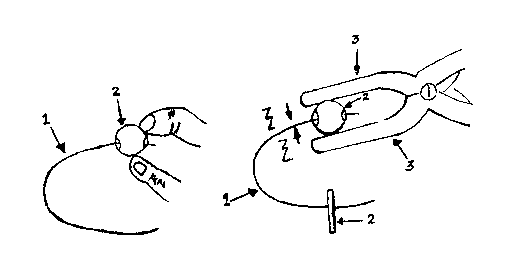Some of the information on this Web page has been provided by external sources. The Government of Canada is not responsible for the accuracy, reliability or currency of the information supplied by external sources. Users wishing to rely upon this information should consult directly with the source of the information. Content provided by external sources is not subject to official languages, privacy and accessibility requirements.
Any discrepancies in the text and image of the Claims and Abstract are due to differing posting times. Text of the Claims and Abstract are posted:
| (12) Patent Application: | (11) CA 2632666 |
|---|---|
| (54) English Title: | METHOD AND KIT WITH TOPS FOR THE CORRECTION OF DENTAL MALOCLUSIONES WITH PREFORMED ARCS OF NITINOL |
| (54) French Title: | METHODE ET TROUSSE COMPRENANT DES ELEMENTS D'ARRET POUR LE TRAITEMENT DE MALOCCLUSIONS DENTAIRES AU MOYEN D'ARCS PREFORMES EN NITINOL |
| Status: | Deemed Abandoned and Beyond the Period of Reinstatement - Pending Response to Notice of Disregarded Communication |
| (51) International Patent Classification (IPC): |
|
|---|---|
| (72) Inventors : |
|
| (73) Owners : |
|
| (71) Applicants : |
|
| (74) Agent: | MBM INTELLECTUAL PROPERTY AGENCY |
| (74) Associate agent: | |
| (45) Issued: | |
| (86) PCT Filing Date: | 2005-12-06 |
| (87) Open to Public Inspection: | 2007-06-14 |
| Availability of licence: | N/A |
| Dedicated to the Public: | N/A |
| (25) Language of filing: | English |
| Patent Cooperation Treaty (PCT): | Yes |
|---|---|
| (86) PCT Filing Number: | PCT/MX2005/000113 |
| (87) International Publication Number: | MX2005000113 |
| (85) National Entry: | 2008-06-06 |
| (30) Application Priority Data: | None |
|---|
The invention relates to a method and a kit for correcting dental
malocclusions. The inventive kit consists of at least one pre-formed arch for
nitinol orthodontics and at least two perforated silver spherules which when
introduced into the arch and deformed remain fixed to the arch, serving as a
stop element. The inventive method consists in: positioning the necessary
elements; aligning the teeth with the application of the preformed nitinol
dental arch, having stop elements abutting thereagainst; closing the spaces;
performing a levelling step; and applying a pretorque and a torque.
L'invention concerne un procédé et un kit de correction de malpositions dentaires, qui comprend au moins un arc préformé pour orthodontie au nitinol, au moins deux sphères en argent perforées qui se fixent solidement à l'arc après leur introduction dans l'arc et leur déformation de manière à servir de butées. Le procédé comprend l'assemblage de l'invention, l'alignement des dents grâce à l'arc dentaire préformé au nitinol présentant des butées plaquées contre celui-ci, la fermeture d'espaces, le nivellement, le précouplage et le couplage.
Note: Claims are shown in the official language in which they were submitted.
Note: Descriptions are shown in the official language in which they were submitted.

2024-08-01:As part of the Next Generation Patents (NGP) transition, the Canadian Patents Database (CPD) now contains a more detailed Event History, which replicates the Event Log of our new back-office solution.
Please note that "Inactive:" events refers to events no longer in use in our new back-office solution.
For a clearer understanding of the status of the application/patent presented on this page, the site Disclaimer , as well as the definitions for Patent , Event History , Maintenance Fee and Payment History should be consulted.
| Description | Date |
|---|---|
| Application Not Reinstated by Deadline | 2009-12-07 |
| Time Limit for Reversal Expired | 2009-12-07 |
| Deemed Abandoned - Failure to Respond to Maintenance Fee Notice | 2008-12-08 |
| Inactive: Cover page published | 2008-09-26 |
| Inactive: Inventor deleted | 2008-09-24 |
| Correct Inventor Requirements Determined Compliant | 2008-09-24 |
| Inactive: Notice - National entry - No RFE | 2008-09-24 |
| Inactive: First IPC assigned | 2008-07-04 |
| Application Received - PCT | 2008-07-03 |
| Inactive: IPRP received | 2008-06-07 |
| Small Entity Declaration Determined Compliant | 2008-06-06 |
| National Entry Requirements Determined Compliant | 2008-06-06 |
| Application Published (Open to Public Inspection) | 2007-06-14 |
| Abandonment Date | Reason | Reinstatement Date |
|---|---|---|
| 2008-12-08 |
The last payment was received on 2008-06-06
Note : If the full payment has not been received on or before the date indicated, a further fee may be required which may be one of the following
Patent fees are adjusted on the 1st of January every year. The amounts above are the current amounts if received by December 31 of the current year.
Please refer to the CIPO
Patent Fees
web page to see all current fee amounts.
| Fee Type | Anniversary Year | Due Date | Paid Date |
|---|---|---|---|
| Basic national fee - small | 2008-06-06 | ||
| MF (application, 2nd anniv.) - small | 02 | 2007-12-06 | 2008-06-06 |
Note: Records showing the ownership history in alphabetical order.
| Current Owners on Record |
|---|
| GRACIELA LANDEROS RAMIREZ |
| Past Owners on Record |
|---|
| None |